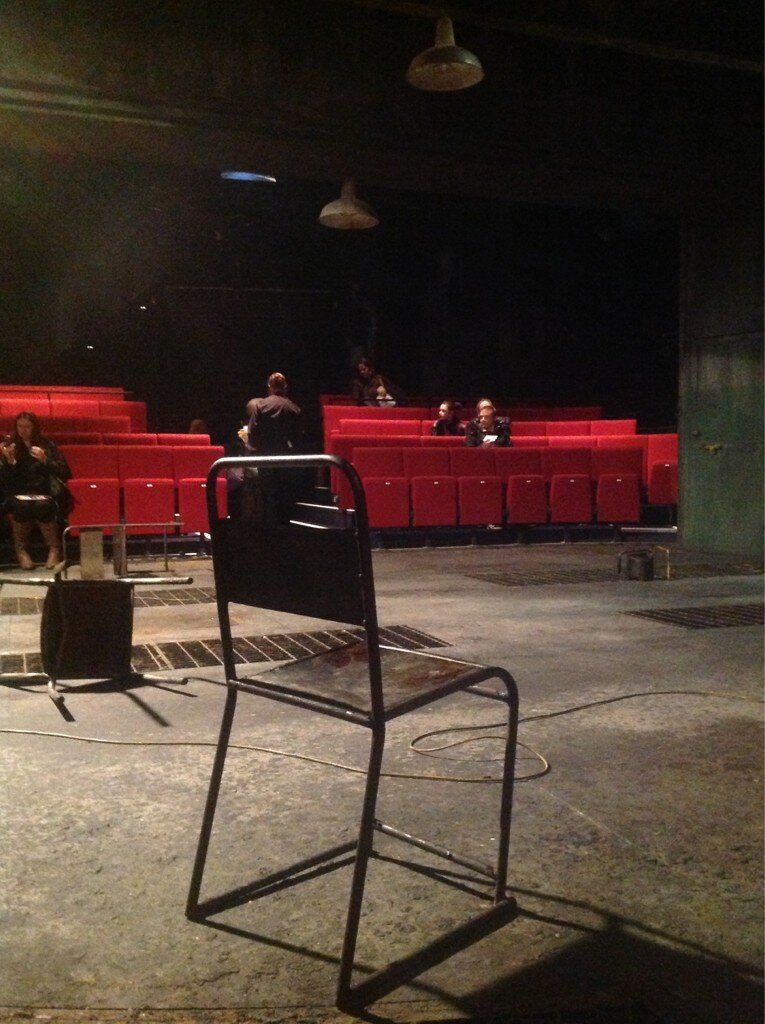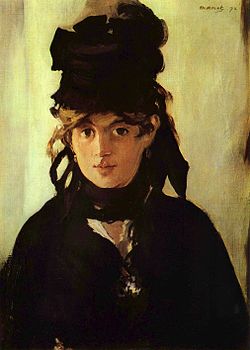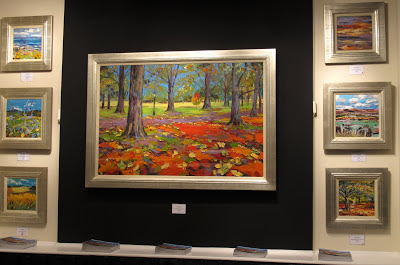Edouard Manet. The father of modern art?
Certainly, if you visit this exhibition of his portraits currently showing at the Royal Academy in London, then that's probably the conclusion you'll come to. Because this is an exhibition that demonstrates that he was an artist of innovation, audacity, honesty, and striking modernism.
The introduction to this show pretty much puts its finger right on why this should be.
Manet was born into a prosperous family in Paris in 1832. Rejecting a career in the Navy, he trained as an artist under academic painter Thomas Couture, and copied Old Masters, especially Dutch painters. So far, so traditional. But he also began painting in an age with new technologies such as photography and the railway, amid a hot-house of innovations and industrial expansion. Exciting times indeed!
But the main thrust is - his well-to-do background meant that not only did he have access to smart Parisian society, with its actors and writers, but crucially he didn't need to make a living as an artist. Thus he could pretty much throw convention aside, with freedom to choose his subjects, composition and technique and please himself. And what pleased him, in these pictures of his friends and family, were images of potent urban realism amidst a palpable modernity.
Take a look at this, from the first room of the exhibition.
Manet, Fishing (Oil on canvas, 1862, Metropolitan Museum of Fine Art, New York
This is a pretty bonkers allegorical mish-mash of collaged together elements. The painting looks like one of those transfer scenes you used to be able to buy for pennies in the newsagents, where you got a background onto which you could rub images of cars or dinosaurs.
The light is coming in from a variety of different directions, you don't know when it's set, and there's little connection between the groups of figures. Nor does there seem to be any focal point, as your eye skids around the scene. It just doesn't engage you.
Six years later, however, Manet is painting this, one of the most enigmatic images in modern art.
Manet, The Luncheon (Oil on canvas, 1868)
Now you're talking!
There are three figures in a an enclosed room, like a stage set, although it's a stage where you don't quite know what the story of the play is, or at what point you've come in at.
There's a maid, who looks out of the picture, a dandyish young man who stares past you, and you can make out a well-to-do older man in a top hat sitting at the table on the right. He looks across at the maid, and blows smoke. There is armor and a sword on the chair on the left, a Dutch-style still-life on the table, with a knife hanging over the table edge, and a cat washing.
What's this scene all about? It's not a scene from history, or a novel. Are we just coming across an everyday domestic moment? What could have happened that's worthy of being committed to this large canvas? Is something about to happen? Has it happened already? And despite the title, no-one's having lunch.
To give you a bit of complicated family background, the boy in the painting is Leon Leenhoff, son of Suzanne Leenhoff, who entered the Manet household in 1849 when she was 19 as music teacher to Manet's two younger brothers. Suzanne had son Leon in 1852. Leon's paternity has always been shrouded in mystery (and was probably a mystery to Leon too) - read more here. However, Suzanne and Manet married in 1863, so it's possible that Manet was the father.
Whilst the man and the woman in the painting aren't exact portraits of Manet and Suzanne, they do have strong physical similarities to them, so they certainly make reference to them. The maid holds a jug with the letter M on it, as if she is a vessel owned by Manet. The man looks at her with an air of nonchalent ownership. She looks with a pride at the back of the boy's head, as he stares, bored and indifferent out of the painting. There are oysters on the table. The cat licks itself. The cutlery hangs literally on a knife's edge. There's an air of sexual tension, of something unresolved, unsaid.
Then there's a whole room of the exhibition devoted to just one painting, Music in the Tuileries Gardens, which usually hangs nearby in the National Gallery in London.
Manet, Music in the Tuileries Gardens (Oil on canvas 1862)
This painting of the Tuileries Gardens in Paris was Manet's first
major work depicting modern city life. The band is playing and a
fashionable crowd has gathered to listen. They look out towards you. You are the band, the performer, there to entertain them.
The picture includes portraits of Manet's family and society friends and family, as well as a portrait of Manet himself. It's a very compositionally complex painting, with a restricted palette, clear brushwork and abstract pictorial components - take those odd bendy trees punctuating the picture plane. It's a huge statement to make, both of modern urban Parisian life and of the act of painting itself, and done the same year as Fishing.
The next room helpfully gives you a chronology of Manet's life, which ended when he was only 51 (after a long illness which resulted in a foot amputation). It's useful to see the large map of Paris, which shows how his friends houses and studios were all clustered together around the Gare St Lazare and the Opera.
Next is Manet's Cultural Circle, both literary and artistic, and the stand-out painting here is of sister-in-law and artist Berthe Morisot.
Manet, Berthe Morisot with a Bouquet of Violets, (Oil on canvas 1872)
It's a small painting, with a figure set in a shallow ambiguous space (as so many of the portraits are). It's difficult to read exactly what's going on with the ribbons of her hat. It's a very restricted colour palette, and you hardly notice the violets of the title.
What does strike you is her eyes. She engages you with a fierce intelligence. It's as though the light comes out of her from within.
Later there is a portrait of her in mourning.
Manet, Berthe Morisot in Mourning (Oil on canvas, 1874)
Here she is completely different. Her face is crumpled in grief, here eyes brimming with tears, fast strokes of paint conveying her fragility.
However, even in her grief, she obviously consented to pose for him, to have spent time sitting and having it recorded for posterity. She was an artist too, so it's a strangely knowing, almost indulgent thing to have done, making the intensity of her grief public, allowing Manet to use it as a subject for a painting.
The section of the exhibition about Manet's cultural circle was less engaging. These are portraits about power, wealth and status, and are consequently less interesting, I found.
Edouard Manet, Portrait of M. Antonin Proust, 1880
But hurrah! What a glorious final room with his model, Victorine Meurant.
Manet met her in 1862, and she posed for seven of his major works, including the scandalous Olympia (sadly not here) and Dejeuner sur l'Herbe, of which a version is included here. Here's the famous version...
Manet, Dejeuner sur l'Herbe (Oil on canvas, 1863)
It doesn't get much more enigmatic than this. The two men are his brothers, there's those bendy trees from the Music in the Tuileries Gardens, those mish-mash transfer-scene groups of oddly-scaled figures from Fishing, the Dutch still-life from The Luncheon, the reference to classical statuary. Victorine has thrown her clothes off, yet stares right at you, perfectly at ease, in fact more at ease than the men with their clothes on. Just what kind of a picnic is this? No wonder it, like Olympia, caused a scandal and became a cultural icon.
And so to the star of the show, the last painting that Victorine sat for, The Railway, glowing on the big dark walls of the Royal Academy.
Manet, The Railway (Oil on canvas 1873)
I've already spoken about the painting in my blog here. Victorine is now 10 years older than she was when she sat for Dejenuner sur l'Herbe, but she doesn't look it. It's one of those paintings that you don't want to walk away from from, and it's worth the price of the ticket alone.
This is a show which has its moments, but also has distinct lulls. Room 3 for example, which contextualises Manet's life and gives you his chronology comes (ironically) at an odd point in the proceedings. Similarly, the society portraits lack spark.
And of course an exhibition entitled Manet: Portraying Life which doesn't have the exemplar of Olympia
Manet, Olympia (Oil on canvas, 1863)
or indeed Dejeuner sur 'Herbe, is always going to be a show which has a giant glaring elephant-in-the-room sized gap at its core. Which means it's a block-busting show which doesn't quite deliver, as it can't truly tell the story of Manet without them.
So there you have it. Manet, father of modern art. Right place, right time, right circumstances. He was accused of painting unfinished pictures - but he stopped when he wanted to, leaving the brushwork to look like both the object and the mark. The spaces are all about urban modernity, and yet are also unreal. The paintings speak of big things, and nothing, of the said and the unsaid, awkward and honest and staged and spontaneous. Critics regularly roasted his work, but he had a large support network of family, friends and polite society, plus the financial backing, which combined to set his vision of modernity free.
Now there's a lucky man.
































_(1).jpg)





















